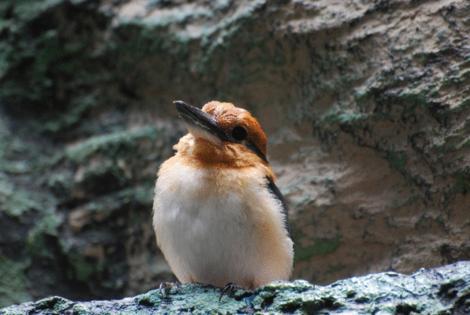Re-introducing the extinct Guam kingfisher one chick at a time
Published in Outdoors
PITTSBURGH — Talk about your precious cargo.
Transporting three chicks of an extinct bird species, the Guam kingfisher, was not a standard procedure, but was doable for Pittsburgh's National Aviary.
Three chicks hand-raised at the Aviary this summer were among nine young kingfishers that in late August became the first to be released since the bird went extinct in the wild in the 1980s.
The birds are not returning to Guam, A U.S. territory, Guam still inundated with invasive brown tree snakes that caused the extinction of the kingfisher and other species, but a new home more than 3,000 miles away.
Although the Guam kingfishers were extinct in the wild, the National Aviary and other zoos have been breeding the birds for decades, diversifying the gene pool to preserve the species and one day help rebuild a wild population.
That day came Aug. 28 when nine juvenile birds were flown to a temporary aviary on The Nature Conservancy's preserve inside a U.S. Fish and Wildlife Service refuge on Palmyra Atoll.
Located 1,000 miles south of Hawaii, the atoll is the only fully protected habitat for birds in the equatorial Pacific, according to The Nature Conservancy.
"It's such a milestone," said Kurt Hundgen, senior director of animal care and conservation programs at the National Aviary in Pittsburgh.
Coordination for breeding and resources for the kingfisher has been in the works for about 40 years, with 20-25 zoos working in collaboration, he said.
The Aviary is working with eight other facilities accredited by the Association of Zoos and Aquariums to boost the population of the extinct kingfisher.
Zoos have become more visible for their work restoring extinct or near-extinct species with preservation programs that increase genetic diversity and breeding.
"People don't realize the significant amount of effort it took to make it to this point," Hundgen said.
How it happened
The Guam kingfisher is called "sihek" by the indigenous CHamoru people.
The male stands 8 inches tall with cinnamon and metallic teal-colored wings, a large head and a heron-like beak. The female has a white breast.
In the wild, the birds eat grasshoppers, lizards, lizards, insects and small crustaceans.
In the 1940s after World War II, U.S. military transports accidentally introduced brown tree snakes to Guam, according to the U.S. State Department.
The snakes eliminated 10 of the 13 native birds and lizard and bat species. One was the Guam rail, which the National Aviary has also been instrumental in breeding and re-introducing.
In the 1980s, as tree snakes decimated Guam's kingfishers, the Association of Zoos and Aquariums and Guam Department of Agriculture rescued 28 of them in the wild, according to the Aviary.
Today, there are 20 or more brown snakes per acre of jungle in Guam, according to local estimates from the U.S. Department of Agriculture.
"These beautiful birds haven't sung in the forests of Guam for more than 30 years, but this exciting moment [is] a pivotal step toward the eventual reintroduction of this stunning creature to Islan Guåhan," said Yolonda Topasna from the Guam Department of Agriculture's Division of Aquatic & Wildlife Resources via The Nature Conservancy website.
Hundgen can attest to the silent forests of Guam, where he conducted fieldwork in the 1990s and 2015.
"It's eerie when you go into the forest and don't hear birds. You hear feral chickens," he said.
Kingfishers' journey
Kingfisher eggs, two from the Aviary birds and another from the Cincinnati Zoo, hatched in a biosecure area to protect them from germs and potential contaminants from other birds, said Brianna Crane, the National Aviary's senior aviculturist.
More than 20 Guam kingfisher chicks have hatched at the Aviary over the last decade.
"We test for everything and isolate the chicks from other birds," she said.
Crane and zoo staff hand-fed the 2-inch kingfisher nestlings every 12 hours.
This summer, Crane took the young kingfishers to the Sihek Translocation Biosecurity Facility at the Sedgwick County Zoo in Wichita, Kan. They were among nine Guam kingfishers hatched and hand-reared at AZA facilities for release into the wild a few weeks ago.
Making the trip to Kansas took lots of planning and a special TSA inspection, Crane said.
She carried the baby kingfishers in a portable incubator with a battery-powered heat source and a fan "to keep the chicks nice and warm."
The young birds from the Aviary will live in a temporary release enclosure in the field.
"We will let them acclimate to the temperatures and see if they can eat in the wild. There will be prey around them," Hundgen said.
Over the years, the Aviary's Guam kingfishers have produced about 22 young, most of which were sent to other zoos for healthy biodiversity, he said.
"The genetics are so important and managed yearly," Hundgen said.
The Aviary will continue to manage and breed its two pairs of Guam kingfishers, which typically produce about two chicks annually. They could use a third pair as well, Hundgen said.
In the meantime, wildlife experts expect Palmyra Atoll to serve as a haven for the species to thrive and establish a breeding population.
The ultimate goal is to return the birds to Guam one day when the threat from brown tree snakes is controlled.
(c)2024 the Pittsburgh Post-Gazette Distributed by Tribune Content Agency, LLC.







Comments